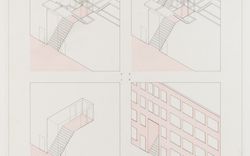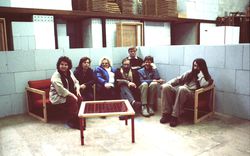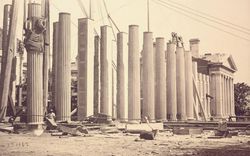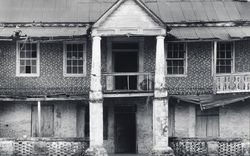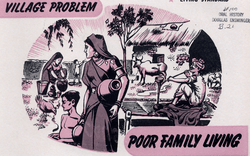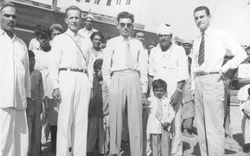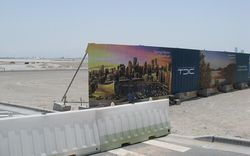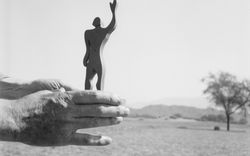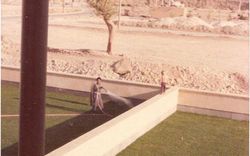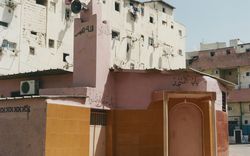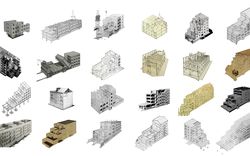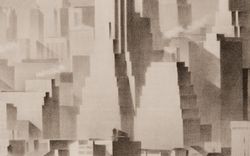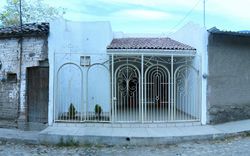How a Soviet Concrete Panel Housing System Came to Cuba and Chile
Research by Pedro Ignacio Alonso
Axonometrics of prefabricated structures from Arkhitektura SSSR, 1956–1962 (volumes 4–9). W.A7935
This grid of images shows a range of examples of Soviet large concrete panel housing systems, as published in the Russian magazine Arkhitektura SSSR from 1956 to 1962. This selection compares mock-ups and axonometric drawings of various experimental systems developed in the Soviet Union after Nikita Khrushchev’s speech to the All-Union Conference of Builders, Architects and Workers in the Building Materials Industry, in December 1954. Each image has been chosen to show both the typology and the assembly process of the respective systems.
Viterbo O’Reilly was an engineer at the Large Soviet Panel plant in Santiago del Cuba. The following is a translation from a conversation with Hugo Palmarola that took place in Havana on 15 March 2011, at CUJAE (the Instituto Superior Politécnico José Antonio Echeverria):
At the beginning of the revolutionary process in Cuba, a number of development projects were taken by surprise by this weather event [Hurricane Flora, 1963], which obviously pushed the Cuban state in another direction. At this stage, there were already very direct relations with the Soviet Union, and at the time of the cyclone I was actually in Moscow, taking a course on prefabrication.
Then Cuba sent a documentary to the Soviet Union about the devastation, and it was screened at our Moscow embassy for Nikita Khrushchev and his daughter. In a gesture of solidarity with Cuba, Khrushchev proposed to donate a factory to produce housing, with a production rate between 1400 and 1700 dwellings per year—which was the I-464 system.
Then problems arose because the housing was designed for Russian conditions. So, on the Cuban side, a commission was created to study, discuss, and improve the design and structural conditions, because—as you can imagine—a large concrete panel in Russia or any other region of the Soviet Union was designed to accommodate snow loads, while in Cuba we had to take into account wind loads.
Pedro Ignacio Alonso investigated the introduction and adaptation of the Soviet KPD large concrete panel housing system to Fidel Castro’s Cuba in the 1960s and to Salvador Allende’s Chile in the 1970s. A collaborative project with designer Hugo Palmarola, the research explores the donation of Soviet factories and technological know-how to these two Latin American countries, and involves multiple media, including photography, film, architectural drawings, and oral history interviews. Alonso and Palmarola published the book Panel in 2014.
In an earlier phase of his research, Alonso spoke with Janet Abrams at the CCA about architecture as a political device, the ideological significance of women working as crane operators, how the panels were modified for their new geographical and social contexts, and the “detective story” of piecing together this triangulated architectural history through archive research and trips to the three countries.
Pedro Ignacio Alonso in conversation with Janet Abrams




Alonso and Palmarola recorded interviews with some of the workers and engineers—now in their 70s and 80s—who were involved in the systems’ adaptation to Cuba and Chile. Audio excerpts from these oral histories, in Spanish, are presented here.
Interview with M. E. Pivet, formerly a crane operator and delegate to the Chilean KPD’s trade union




Interview with V. O’Reilly, formerly an engineer at the Large Soviet Panel plant in Santiago de Cuba




Interview with A. Arenas, formerly head of the Sub-Department of Industrialized Housing at CORVI under Salvador Allende in Chile




Interview with M. Ramírez, a worker at the KPD Factory between 1971 and 1973 and formerly president of the KPD’s Agrupación de Exonerados Políticos




Pedro Ignacio Alonso was in residence here in 2011 as a Visiting Scholar.
